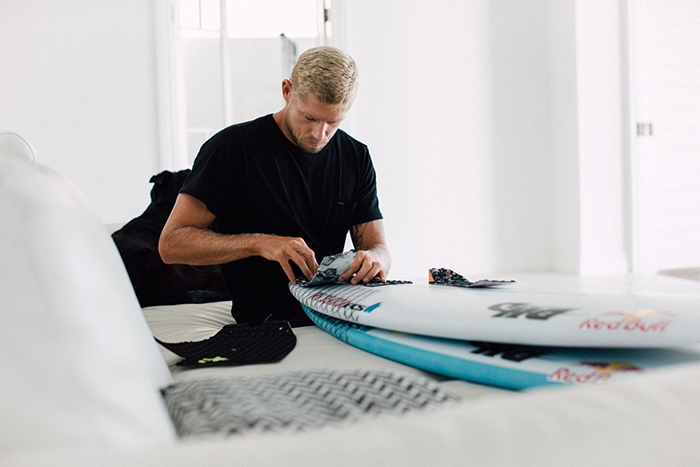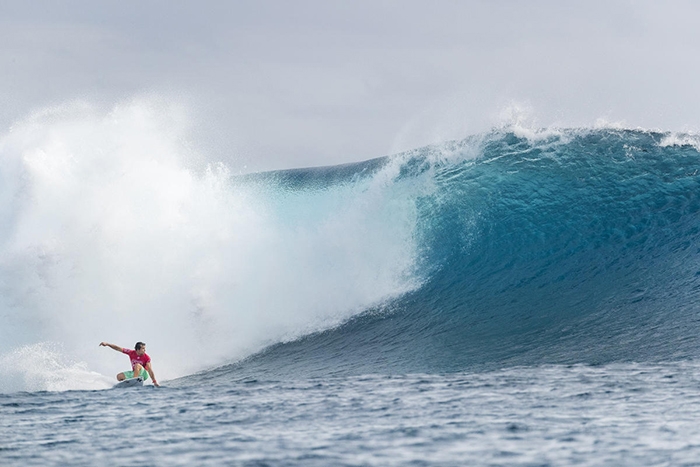Selecting the Right Tail Pad
The amount of tail pads out on the market currently is crazy! And with more brands coming out daily, it really gives surfers an awful lot of traction options to choose from. More often than not, when we treat ourselves to a new stick, we instantly become creatures of habit, reverting to the comforts that we know with the attitude of “yeah that will do.” I guess you're reading this and thinking, “well actually I just grab the one I like.” When in-fact there’s more to it. Each pad has its own purpose, and the design of them actually benefits your surfing.
Unlike Surfboard Fins, we don’t have the liberty to change our surfboard tail pads regularly. We’ve compiled a little insight list to give you some clues in what to look for when buying a new grip.
What is a Surfboard Traction Pad?
One of the first things you observe when picking up a surfboard for the first time is that board’s surface is slippery. When it comes to surfing, water and a slippery surfboard aren’t exactly the best combination. To solve this, surfers use two methods for getting better traction: traction pads and wax application.
Surfboard traction pads or surfing grip pads are pieces of foam that are usually placed near the tail area of the board where the rear foot is placed. Surfers generally prefer traction pads over wax because it is a one time install and eliminates the need for constant waxing. These are also perfect for beginners since it gives them a reference point on where they can place their foot, helping them improve their stance in the process.
How to Choose a Surfboard Traction Pad
Selecting a traction pad boils down to two major factors: style and functionality. While style involves personal taste and there is no shortage of designs out there, function requires a little bit of thinking. The best way to shop is to first figure out what you want with your traction board in terms of functionality and then select the best design after.
One or multiple pieces
A single piece traction pad is easier to install but may not be a perfect fit for all surfboards. A two- or three-piece traction pad, on the other hand, allows for better customization. Depending on how specialized your surfboard, you could use multiple traction pads of up to five if need be. While this makes it easy for you to tailor-fit your installation it also has its downsides. These are harder to install and are easier to peel because each piece has a lesser surface area to stick to.
Raised or no raised arch
A raised arch offers you better stability when your surfing style involves a lot of foot slamming on the traction pad. However, it limits your foot’s mobility as the arch may get in the way of smoother transitions as you move your foot around the tail.
High versus low kick
The kick functions like a stop that prevents you from kicking your rear foot off when making turns. Higher kicks are designed for more aggressive surfers. For everyday surfing or those who simply cruise over the waves, 20-degree kicks should do the job.
Using a front deck grip or not
Most surfers can do away with a front deck grip. These certainly look good on a board but if you’re not planning to do massive airs then you can skip this altogether. Front deck grip provides surfers the additional benefit of having their foot planted during big airs giving them better control over their surfboards.
Surfboard traction pad material
Another important thing to check when shopping for traction pads are the materials used for its construction. The type of rubber foam used determines how it reacts to water. Look for something that provides great traction while maintaining its integrity when wet. Today’s traction pads are more capable after undergoing several upgrades since its introduction in the 1970s. These are now made from Thermoformed EVA and available in a variety of shapes, arches, and colors.
Surfboard traction pad styles
Although this is considered as a matter of personal preference and does not have anything to do with a traction pad’s performance, selecting a traction pad that works with your taste makes it personally rewarding. With surfboard grip pads coming in different shapes, styles, and colors finding the perfect traction pad that complements your surfboard is easy.
When Should You Use a Surfboard Tail Pad?
Traction pads are designed for maximum grip and sure beats the trouble of waxing the surfboard every time you have to use it. Surfing traction pads enhance performance and makes surfing more enjoyable. It helps you stand up faster, makes it easier for you to plant your foot, and helps improve your stance.
Surfing traction pads work as an anchor when you're maneuvering the waves or doing turns. These are also ideal for cruising or just standing up on the surfboard. Traction pads are often seen on shortboards. It is because shortboards have a small surface area so it important that you maintain optimum stance. A traction pad can act as a guide for proper foot placement.
There’s just no downside to using surfing grip pads. These are perfect for any surfing condition or any skill level. Anything that gives you better control over your surfboard or helps you maintain proper stance is always a plus for any surfer.
The Four Essential Components to Tail Pads
Kick
The degrees in which the kick in the pad sits, ranges anywhere between a mellow 20 degrees right up to vertical and steep kicks. The steeper the kick, the easier it is to jam your back foot in place to blow the back of the wave out. If its vertical and performance surfing you like, a kick between 45 degrees to vertical is perfect for your needs. If it’s a pad you need for a fish/retro board, a mellow flat tail pad is your answer.
Arch
The amount of difference in arch design alone is incredibly broad. However, it all comes down to the size of your foot and how much movement you like to have. If you’ve got smaller feet, a pad with a small to minimal arch would be best. However if you’ve got a big foot, then look for something with a longer higher arch that nearly runs the length of the tail pad.

Mick carefully applying a tail pad to his DHD surfboard.
Number of Pieces
From one piece to five pieces, they’re designed to effectively be usable on most boards.
- One piece pads aren’t as common nowadays as they were a good 10+ years ago, however they have made a come back recently for their durability.
- For a while the two piece pads were seen as the weird uncle to the three pieces. Featuring no arch and a mellow kick, these pads are great if your throwing something down on the rear of your fish.
- 3 pieces are the most common grips, allowing for an even spread of grip and versatility for all board models.
- 5 pieces are effectively the 3 piece grip but with two tabs that sit above the main area of the tail pad adding extra grip in bigger swell.
Traction
The grooves themselves are more often than not shaped like diamonds and some feature multi layered grooves while others feature a single layer groove. Circular designed traction are also starting to make an appearance amongst some manufactures. However, the basic rule of thumb is the rougher the grooves, the greater the traction. This provides maximum resistance against slipping and maximum grip, but will still allow you to move your foot about when needed.
A single layer groove generally is a straightforward design that allows both grip and movement. A multi layered groove looks like a diamond with another diamond on top. These are the grippiest of the grippy. Once your foot is down it isn’t moving anytime soon. And if it does, it’s against its own free will.
So What’s The Best Tail Pad For Me?

More often than not, it’s personal preference of what works best for you. However, consider the board you want to apply it to as the basis for your decision.
How many pieces do I need?
- Does the kick have a high enough support or do I need to change to something with less kick?
- Consider the arch and how your foot would relate to it.
- What kind of waves are you looking to use your board in?
- Do you need something with ultimate traction or something that lets you shift around freely?
- Thoroughly clean the surfboard’s surface. Remove any wax, residues, or any impurities.
- Measure twice cut once. No cutting necessary but this tip still applies here. Carefully measure where you would like to position each piece and mark this.
- Remove the adhesive cover and gently stick it on the surfboard starting from one end going to the other. Applying pressure while doing this to remove any air bubbles.
- Let the traction pad sit for at least a day before using it. This can also be referred to as ‘curing time.’ This gives the traction pad’s adhesive enough time to properly settle with the board's surface.
Once you’ve answered these questions, apply the pad and you're good to go. Just remember you don’t want to be playing around with them too much or you’ll lose your sticky adhesive. The unfortunate thing is once its been stuck on your board, leave it. We’ve seen surfers try use the old hair dryer and paint scraper trick to remove it but in all honesty, if you must through that much trouble to remove the tail pad, it could be time for a new board!
Installing a Traction Pad on your Surfboard
How long and how well your traction pad sticks on your surfboard depends on how well it is installed. Below are the steps on how to professionally install your surfboard grip pad:
Surfboard Traction Pads – Good or Bad Idea
Are traction pads a good idea? The short answer is Yes! Traction pads give you grip hence, better control over your surfboard. Anything that enhances your performance is definitely a plus in anyone’s book. It makes turns easier and saves you from the trouble of constantly waxing your surfboard every time you use them. In contrast, if you're more focused on the price aspect, opting for surf wax can be a cost-effective alternative to traction pads.
Popular Tail Pads
Shop All Tail Pads
















